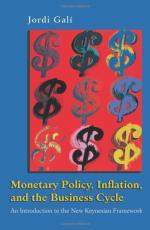|
This section contains 1,197 words (approx. 4 pages at 300 words per page) |

|
Monetary Policy
Summary: A macroeconomic policy intended to minimize inflation, reduce unemployment levels, and maintain a sustainable rate of growth, monetary policy involves direct influence by a government to affect the cost and availability of money and therefore credit in a nation's economy. The following provides a better understanding of how Australia's monetary policy is conducted and the issues involved.
Monetary policy is a macroeconomic policy that is used to smooth the effects of fluctuations in the business cycle and influence the level of economic activity, output, employment, inflation, and other objectives. It involves action by the RBA, on behalf of the govt. to influence the cost and availability of money and therefore credit in the economy.
The main instrument of the MP is Domestic market Operations (DMO). When the supply of funds in the official short term money market increases, the price of borrowing this money, the cash rate of interest, falls. On the other hand, when the supply of funds in the settlements market decreases, the cash rate will rise. The RBA can exercise direct control over the supply of funds in the overnight money market by selling or buying second hand government securities, the process known as DMO. By selling these securities, the RBA decreases...
|
This section contains 1,197 words (approx. 4 pages at 300 words per page) |

|


